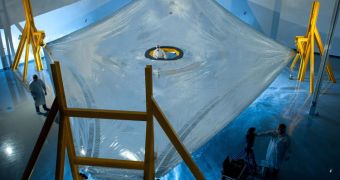Officials at Northrop Grumman Corporation, one of two main contractors on NASA's next-generation James Webb Space Telescope (JWST), announce that yet another critical component for the future spacecraft has been completed, and passed an important design review.
Scientists at the company recently completed engineering design of an important structure that will ensure the JWST tennis court-sized sunshield will stay aligned and in place. This is the largest sunshield ever developed for a spacecraft.
It is made up of five distinct layers, each of them extremely large. Due to their size, they cannot be sent to space in their final configuration, so they have to be folded. When the JWST reaches its destination, the L2 Lagrangian point, automated mechanisms will deploy and extend the sunshield.
After this happens, the support structure will have to keep the protective shielding in place, and properly oriented. If this is not done precisely, then stray light may enter the telescope's extremely sensitive instruments, rendering them unable to observe the beginning of the Universe.
Northrop officials say that the support structure has yet to be fabricated. This Critical Design Review was meant to assess the engineering aspects of the component. The company will now move forward with construction.
“This sunshield support structure balances the sunshield's weight and tension so that it remains stable. The structure is very strong, yet quite light, weighing only 63 kilograms or 139 pounds, while supporting the sunshield itself, which weighs 700 kilograms or 1,543 pounds,” says Andy Cohen.
“The spacecraft is the foundation for the entire observatory and it provides the stability, strength and vibration suppression that allows the telescope to operate as designed,” adds the official, who is the spacecraft manager for the JWST, at Northrop Grumman Aerospace Systems.
The company has already made significant progress in putting the telescope together. At its facility in Redondo Beach, California, engineers have already constructed a primary spacecraft model, which they are using for various tests and assessments.
Currently billed at $8.8 billion, the JWST is being developed to replace the Hubble Space Telescope as NASA's flagship observatory, and will be the most advanced spacecraft of this type ever sent to space. The American space agency plans to launch it in 2018.

 14 DAY TRIAL //
14 DAY TRIAL //